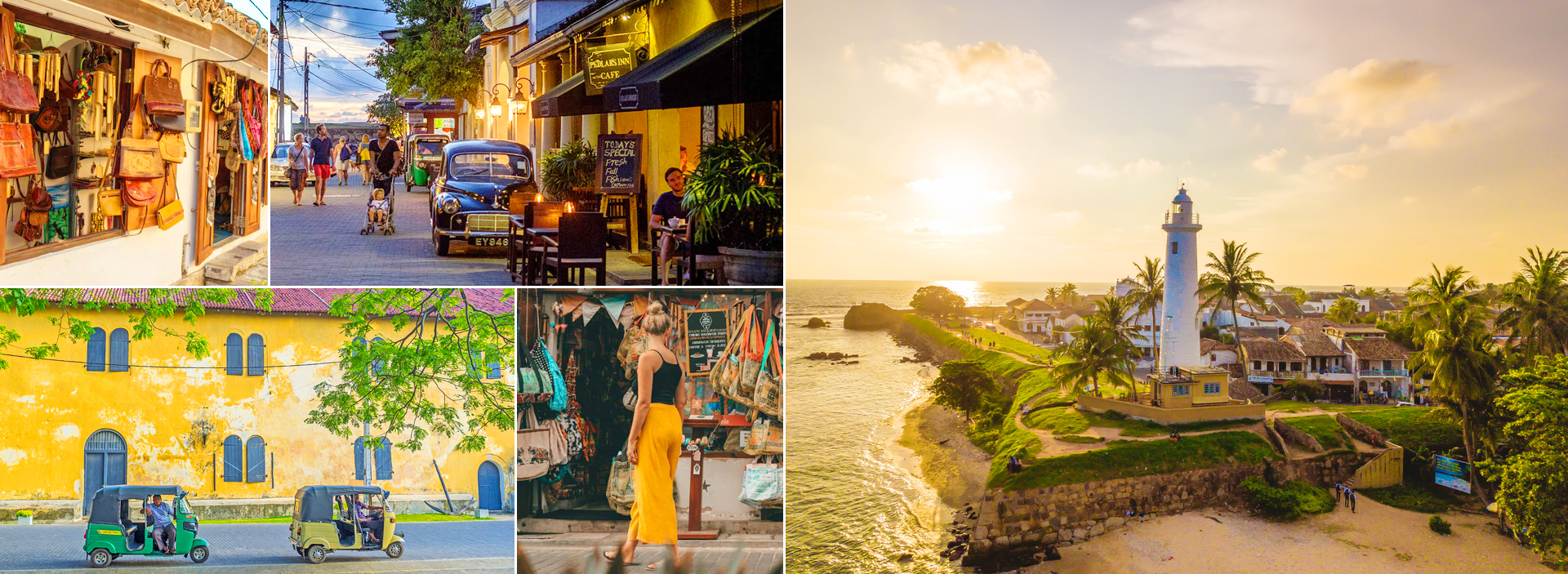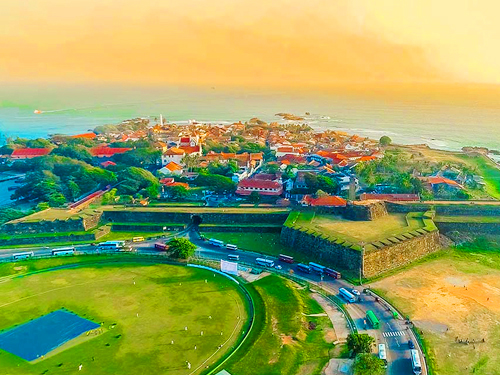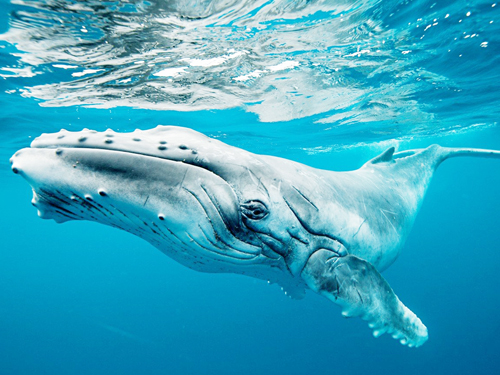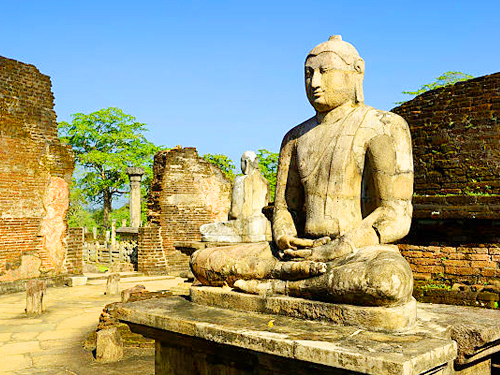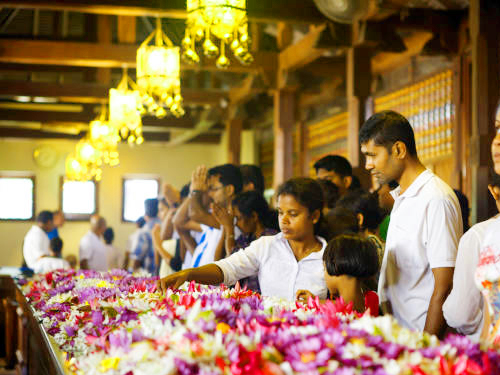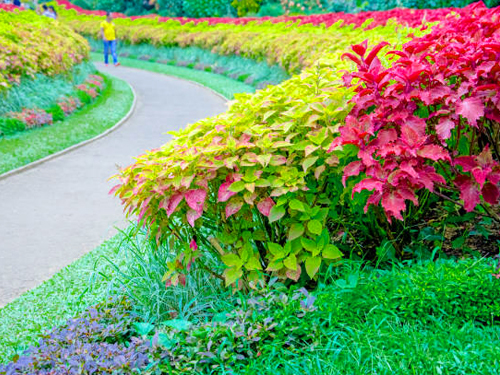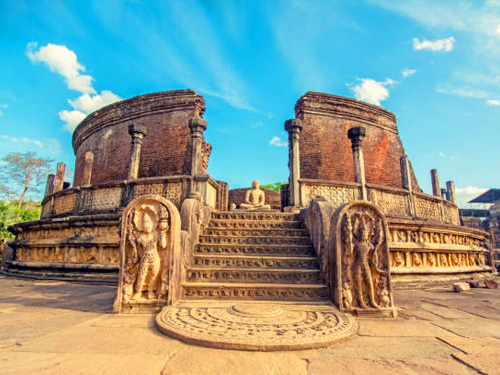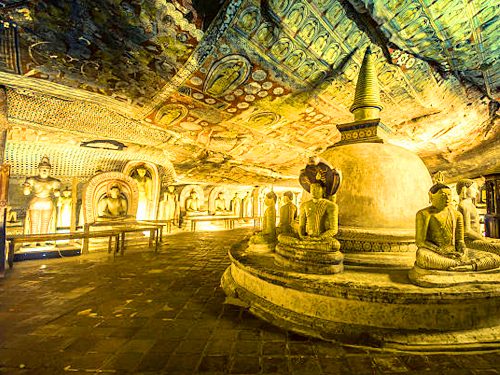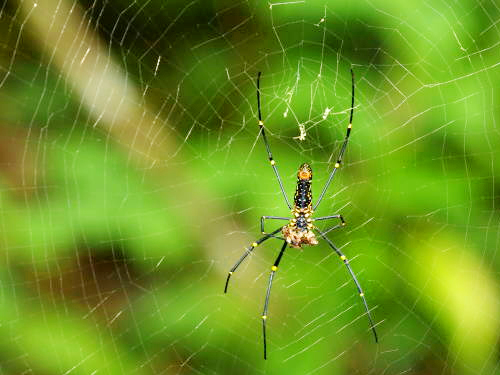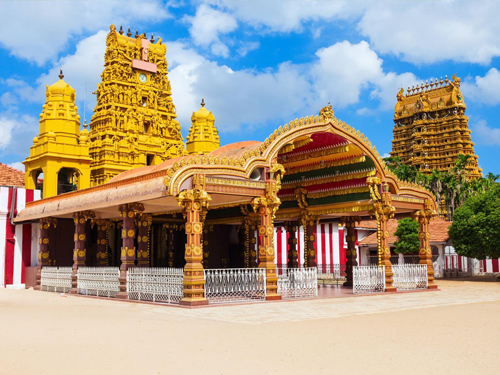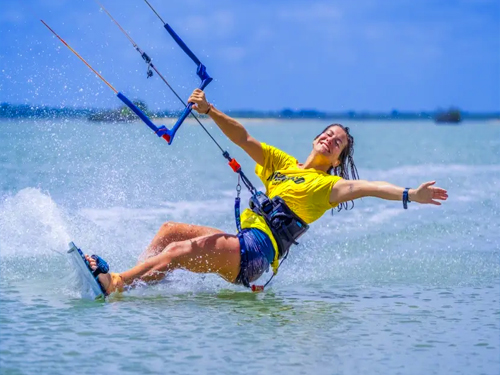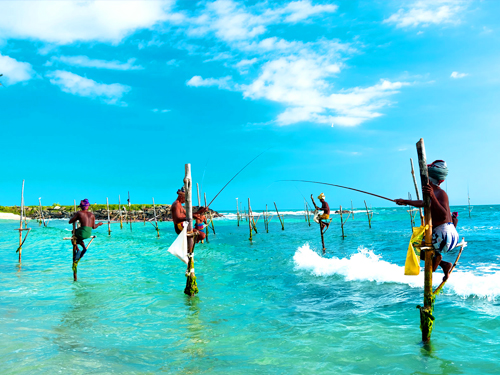Galle in Sri Lanka
History of Galle
James Emerson Tennent claims that Galle was an ancient port of Tarshish from which King Solomon drew ivory and peacocks, among other valuables. As the root of the word is Hebrew, Galle could have been the main hub for cinnamon exports from Sri Lanka.
Galle may have been known by ancient Greek and Roman geographers. Ptolemy may have also known about the port, which he called Odoka. In 1342, Ibn Battuta, a Moroccan traveller, visited Galle (or Qali to his liking). In Galle and the surrounding areas, Sinhalese fleeing Tamil armies settled during the 12th and the 13th centuries.
Galle was a major seaport before the western rule of the country. Many foreigners, including Persians and Arabs, Greeks as well as Romans, Malays and Indians, had done business through Galle's port. Galle Trilingual Inscription was built in 1411 to mark the Chinese admiral Zheng He's second visit to Ceylon. It is a three-language stone tablet inscription, in Persian, Tamil, and Chinese. A small fleet of Portuguese ships under Lourenco de Almamida's command was blown off course in a storm on their way to Maldives. After a short stop in Galle, Lourenco realized that King Colombo was in Kotte.
The Dutch East India Company forced the Portuguese to surrender in 1640. The Dutch constructed the current fort in 1663. They constructed a solid granite wall fortification and three bastions that are now known as "Sun", 'Moon, and "Star".
Galle District
Galle is located in Southern Province, Sri Lanka. It is the second-level administrative division of Sri Lanka. A District Secretary, formerly known as a Government Agent, is responsible for administering the district. He was appointed by Sri Lanka's central government. The British took control of Sri Lanka from the Dutch in 1796 and kept the fort intact. They used the fort as the administrative center of the district.
UNESCO world heritage of Galle
The famous bay of Galle, which is surrounded by picturesque scenery, can be found on the southwest coast of the island. Its history dates back to 545 AC and is one of the oldest ports in the Cosmography of CosmasIncopleustes. When the Portuguese arrived in the country, it was the main port. The Portuguese retreated from the Colombo region and built a fortress in Galle to defend against land-based attacks at the end of the 16th century. It included a rampart, three bastions, and earthen banks and palisades. After the Dutch captured the area in 1640, Galle Fort - Sri Lanka UNESCO World Heritage Site was modified to enclose the entire peninsula with a bastioned rock wall that delineated their supreme power over it.
Galle Fort, which can be seen today, is a fortified city that was built in the Dutch period on an area of 52 hectares. The walls that surround the area were constructed in 1663 and were defended by 14 bastions, both from landside as well as seaside. The city is surrounded by a drawbridge and ditch. It also has a grid layout that runs parallel to the ramparts. Galle city was established as a hub for public administration, trade establishments and religious activities in 1729, after the construction of the sea wall. This is evident in the churches, particularly the oldest Protestant baroque-style Church in Sri Lanka, built in 1775, Commandant's Residence, the arsenal, powder house and the warhouses. To highlight trade development and military security, prominent features include the barracks, naval guardhouse, ropemaking, forge, and carpentry workshops, as well as the ropemaking and ropemaking workshops.
Galle Fort, which was established as an administrative center in the south of Ceylon by the British in 1796, was controlled by the British. The fortification was also modified during their time. A gate was built between the Sun bastion and the Moon bastion. A lighthouse was established on the Utrecht bastion. Also, a new blockhouse was constructed. The British made many changes to the fort in the Second World War with the intent of strengthening its defensive role.
Galle Fort – Sri Lanka remains the best-preserved example of a fortified city in Asia. It reflects the mixture of European architectural styles with South Asian traditions. Under the title Old Town of Galle, Galle Dutch Fort and its Fortifications, UNESCO designated Galle Dutch Fort a World Heritage in 1988.
Outer Gate
You can reach the Galle Fort's old outer gate - Sri Lanka by entering from the road running parallel to the beach. This gate features a large plaque with the Royal Emblem of Ireland carved on it. It dates back to King George III of England's time and was placed after Galle's capture by the British. This plaque displays the British Crown, which is represented by a lion on its right and a unicorn on its left. A strip is placed at the plaque that marks the motto of the British Emperor (Dieuet Mon Droit), which means 'GOD’S and MY DOMAIN. This plaque now contains the Coat-of-Arms for the VOC. It was previously located above the inner archway. This plaque and the old gate that contained it are a reminder of how the British took over administration of Fort Fort from the Dutch in 1796.
Inner Gate
Built a palisade in front of the Gate during the Portuguese period around 1620. After the Dutch arrived, the entrance was made a part of a large warehouse that connected to the rampart. The main entrance to the warehouse is marked with the emblem of the Dutch East India Company. The monogram of VOC is used to represent the Dutch East India Company's name. The picture above shows a rooster on a rock. This reminds us of the legend about the discovery of Galle in Portugal. The date of completion of the gate is shown at the bottom of this plaque: 1669 AD. The British added this emblem to the inner face of the Main Gate, replacing the one that was on the front face.
Maritime Museum
Galle's Maritime Museum was established in 1992 and functions under the Department of National Museums. The museum features exhibits on Sri Lankan culture and marine life. These include single-cell life forms, large blue whales, and tiny single-cell organisms. The museum displays habitats for all of these creatures, including mangroves and salty wetlands. It also displays various types of boats, water rafts and lifestyles of the Sri Lankan fishing villages through replicas and models. This museum was nearly destroyed by the tsunami that struck Sri Lanka on 26 December 2004. It was reopened to the public in 2009 after being renovated.
The Central Cultural Fund opened the Maritime Archaeology Museum to the public on March 4, 2010. It is located at Galle Fort - Sri Lanka's Dutch warehouse. This museum is the only one that focuses on the marine biological as well as anthropological aspects along the Southern coast of Sri Lanka. Seven display galleries house artifacts related to the maritime archaeology of Sri Lanka. The majority of the underwater artifacts in the museum were found in Galle harbor after underwater expeditions to the wrecks of The Hercules (1661), and Avondster (1659). Museum exhibits include objects, replicas and models as well as information on panels and videos. They cover the entire country's history, from 5000 BCE up to the end of the 19th century CE.
National Museum of Galle Fort
The National Museum in Galle was established on the site of the former New Oriental Hotel. It was first opened to the public on 28 March 1986. It is managed by the Department of National Museums as a provincial museum. It was part of the building that was destroyed in 1865 to make way for the New Oriental Hotel. The museum's main purpose is to preserve the cultural and social heritage of Sri Lanka's Southern Province. It also provides education, knowledge and entertainment. The museum has three galleries. The first shows the Galle Fort - Sri Lanka's historic Galle Fort, and the cultural and historical heritage of the Southern Province. The second gallery displays artifacts from the colonial era. While the third exhibits the historical relations between Sri Lanka and China.
The Dutch Reformed Church
The Dutch Reformed Church in Galle Fort, Sri Lanka is well-known as the Groote Kerk. It was built in 1755. It is one of the oldest and most prominent churches still in use. It was built by Abraham Anthonisz on the 4th July 1752. According to a tradition, the Church was built as a thanks offering to God for the birth of a girl to the Commander of Galle, Casparus De Jong (Lord de Spanbroek), and Geertruyda Adriana Le Grand. This church is located down Church Street and has gables on the western and eastern walls, but no tower. The Galle church was built on the site of a Portuguese convent. It also has a well-tended graveyard, crypt and small cemetery. It was built in the Doric style, similar to the Wolvendaal church in Colombo. It also has a cruciform shape, but the transepts in it are shorter. This church, with its magnificent gables, is the best example of this type of church in Sri Lanka.
Churchyard and Tombstones
A churchyard is a sacred place for burials. It represents the practice of placing a memorial tablet in the cemetery in honor of the deceased. The burials of high-ranking, distinguished people were given priority. All others received a spot within the courtyard. This privilege was not available to natives. Most tombstones have text in Dutch. It is composed in a set design and framed with ornamented designs, as well as the heraldry of deceased. The common symbol on most tombstones is the hourglass, skull and crossbones, which symbolize the uncertainty of living. The burial vault of the church is located beneath the entire area of the head-of-the cross. It was also a privilege to have the remains of the church's deceased buried in this vault, even though it cost a lot. The vault has been closed. The last burial in the vault was in 1863.
Anglican Church
The Commander's residence is home to the Anglican Church, or All Saint's Church. It was dedicated during the British regime of 21 February 1871. Services are still held there today. The church is believed to have been built on the site where once stood the Magistrate's Court House. James G. Smither, Sri Lanka's most prominent architect of the 19th Century designed this magnificent structure. It was constructed on a basilican plan using a Victorian Gothic Revival style architecture. The design was modified to adapt to local climate conditions. The Church's plan is cruciform and supported by stone columns. It also has arches made of timber. Masonry arches made from lime mortar and local kabuk. Burmese teak is used to make the heavy pews and sanctuary with the carvings of the Jewish Star of David.
Sun Bastion
In 1620, the Portuguese completed the main defense works on the landside with three bastions. The one to the south was named after Sao Iago (St. James), a Roman Catholic saint. The Portuguese had power over the sea and were cautious about native attacks. They expected greater protection from the landside rather than the seaside. It was rebuilt by the Dutch and renamed Sun Bastion by Hester de Solmne on 4th August 1667. Shester, who was the fiancee of Governor Rijcklof Van Goens, fired the cannons that were stationed there after the Dutch had conquered. The bastion's base was strengthened in 1697. This bastion was home to 15 canons by 1760. It offers a stunning view looking south, overlooking the natural harbour and Rumassala mountain range.
Moon Bastion
The Moon Bastion is the central-northern bastion at Galle Fort, Sri Lanka. Conceycao was the Portuguese name for this bastion, which means "pure conception". The Dutch initially called it the Middle Point. In 1667, Hester de Solemne reconstructed the severely damaged bastion and renamed it the Moon Bastion. This was also referred to as the Sun Bastion. This bastion was the strongest and largest of the three that faced the mainland. This bastion was equipped with 19 cannons by 1760. The drawbridge passed the Main Gateway from the landside, which was attached to this Bastion. The rampart had a wide path that ran between Sun and Star Bastion, where soldiers could have marched to see any dangers from the land.
Star Bastion
The star bastion, located at the northern end of the island, was originally named Sao Antonio (St. Anthony's) by the Portuguese. It was first called the Zee Punt (Sea Bastion) by the Dutch. It was given the name Star Bastion in 1667 by Commander AdriaanRoothaas's wife. To commemorate the occasion, the Dutch Commander's daughter fired the first cannon. This bastion had 6 canons by the year 1760.
The white-painted lighthouse was situated on the Utrtecht Bastion on Galle Harbor's western side. It has a full view of all ships entering Galle Harbour. This lighthouse was built to replace the flag rock iron structure, which was destroyed in 1939. This lighthouse was built in 1940. It is located 92 feet above sea level and is approximately 6 meters (20ft) higher than the ramparts road. Original light was equipped with a prism glass lens suspended in mercury to reduce friction. It was powered by a weight-driven motor.
Hospital Building
The Old Galle Dutch Hospital, one of the oldest buildings within the Galle Fort region, dates back to the Dutch colonial period. It has been used for many different purposes over the years. It was built on the same site as the Black Fort and the Aurora bastion. Galle hospital was established by the Dutch to care for the health of officers and other personnel serving under the Dutch East India Company. The British first used the building in 1850 for the office of Galle Kachcheri, or the Office of Government Agent of Southern Province. It is amazing to see that Smallpox experiments were carried out in this building, as the deadly disease was already widespread in the area of Galle prior to smallpox vaccine in Europe. The historic architecture was preserved and the building was transformed into a shopping and dining area. It is a Dutch colonial-style building from the seventeenth century. The walls measure 50 cm (20 inches) thick, as with many Dutch buildings from the same era. Massive teak beams are featured in the structure. A wooden staircase can take you to the upper level. The wooden floor is found on the upper story. The building's wing has a long, open veranda that runs the length of the building.
Law Courts
The VOC introduced the Roman-Dutch law to their newly acquired East territories, including Sri Lanka. It was adopted by the VOC to their newly acquired territories in the East, including Sri Lanka. In 1656 it was made the law for the maritime districts of Sri Lanka. It was adopted by the British and became the Common Law of Sri Lanka. Each of the three judicial districts of Jaffna and Galle had seven members. They were each appointed by the Governor from officers of the Company in Sri Lanka. The civil and judicial powers were simultaneously held by the Commander of Galle. The Council of Justice was an institution that existed in the 18th century. It was moved to the present structure shortly after independence in 1948. Because it stands in front of Galle’s Magistrates Court building, it is also called Court Square. Each corner has four columns of white that support a pyramidal clay roof made in the old colonial Dutch design.
Galle Fort Ambalama
Galle Fort Ambalama can be found in the open space at Courthouse square, which is located at the far end. It is simple and made of bricks and mortar, with its roof supported by four pillars. Although the Ambalama is on a raised platform, it does not have side walls like other brick-and mortar ambalamas. In 2008, the Ambalama building was renovated.
Climate of Galle
Galle has a tropical rainforest climate. Although there is no dry season in Galle, it is noticeably dryer in January and February. Temperatures are consistent with similar climate cities, with the average temperature hovering around 26 degrees Celsius (79 degrees F) throughout the year.
Galle is home to the most famous attraction and other things to do
One of five historic monuments that one should visit in Sri Lanka is the Galle Fort. It can be found on the country's southern coast. The Portuguese built the fort, but it was later modified by Dutch. The Galle Fort, which is now a UNESCO World Heritage Site, is a striking blend of archaeology, architecture and history in a tropical setting.
Locals and tourists alike love the Galle Fort's historical appeal. But it is also because of the lively atmosphere inside, which includes cafes, shops, museums, villas, and lifestyle shops that will complete your Galle Fort experience. All these sites can be accessed by taking a stroll through the lovely structures. This is free and open to all. If you have extra time, you can go through the walls around the perimeter. There are several steps that will take you up there.
Galle Fort Lighthouse is one of the oldest lighthouses in Sri Lanka. It can be found inside Galle Fort. It was originally built in 1848. Because of its beautiful surroundings, it is a popular attraction within Galle Fort. Visitors are not permitted to climb the lighthouse's top.
The fully-automated lighthouse, which stands at 26.5 metres high, is still in operation. You can relax or take stunning photos of the landscape.
Jungle Beach is one of Unawatuna's lesser-known treasures. This beautiful, calm beach is located between Unawatuna& Galle. Although the beach isn't as accessible as other beaches in the city, you can still access it by walking or taking a trip on foot. You might also enjoy a boat ride that will give you a new experience.
Jungle Beach is best visited in the dry season (December to March). People flock to these beaches during the dry season for many enjoyable activities. The shoulder season is the period between April and November, which falls between the monsoons. Weather in the region can be unpredictable with rainy and sunny days on alternate days. Rain lovers will find this beach a great place to take in the natural beauty of Jungle Beach.
Galle offers so much more than its famous historical fort and attractions. Galle's Old Dutch Market is also known as the Green Market. It is popular with both locals and tourists. It is located in Unawatuna, a 300-year-old european-style structure with large white pillars. This impressive, T-shaped structure is located on the west side of town. It has a steeply pitched roof, three conical towers, and an entrance at the peak. It has an open-sided design and is backed by massive wooden beams and columns.
Wood apple and rambutan are two of the most common fresh produce that you will find at the market. They are also native to the region and some of the local favourites. You can also find other staple ingredients for Sri Lankan cuisines at the market. Visit the Old Dutch Market to see the authentic Sri Lankan market with some history.
The Galle Fort is a tourist attraction on the south coast of Sri Lanka. It can be found within the Bay of Galle. The Fort was built by the Portuguese in 1588, and fortified by Dutch in 17th century. It has remained intact for more than 400 years. Flag Rock, at its southern tip, is a bastion where the Dutch used flags to signal approaching ships of the danger ahead. Prior to the Galle Lighthouse's construction, when visibility was poor, the Dutch used flags to signal approaching ships. Instead, muskets were fired from nearby Pigeon Island, warning them of sharp rocks beneath the surface.
Flag Rock, which is located near Galle Fort, is a popular spot to see the sunset. To the east, the Triton Bastion's historic landmarks are visible. The Galle Lighthouse can be seen to the west. It is common to see locals jumping into the water below from street food vendors selling spiced fruits. Although it is not recommended for tourists, there are many people who sell spiced fruit on their carts to sunset-watchers. Rampart Street runs from Flag Rock to the Neptune Bastion and is home to many cafes with great views of sunset.
The Japanese Peace Pagoda, located just a few kilometers from Galle is a unique shrine which guarantees peace and solitude for all who visit it. It was built by the Japanese NipponzanMyohoji order, in 2005 as a symbol of peace on the island. It's a short climb to the top of Rumassala Hill, where you will be awestruck by the magnificent pagoda. When you reach the top, enjoy the stunning views over the coastline and bustling town Galle.
You can visit the Peace Pagoda perched high on Rumassala Hill before taking a refreshing dip in Jungle Beach. For a relaxing and restful experience, return to Taru Villas – Rampart Street in Galle Fort.
Galle's international stadium had the Indian Ocean visible from two sides and the clocktower of the Dutch 16-century fort rising above. It was one of the most picturesque venues in the world until the tsunami of December 26, 2004 that devastated the entire Southern coast. The future of the venue was uncertain for a while, especially considering the political schisms in Sri Lanka's cricket administration. But, thanks to international support from luminaries such as Shane Warne and Ian Botham, which had already taken his 500th Test wicket there earlier that year, the pledge was made to rebuild it from scratch. This work was completed in the time frame allowed by England to visit the stadium in 2008. Galle was a stronghold for Sri Lanka, having won six and lost two matches in the 11-match series. The majority of those were engineered by MuttiahMuralitharan who had previously taken 87 wickets.
Dalawella beach, located in the Unawatuna region of Sri Lanka's south coast, is one of the most beautiful beaches in Sri Lanka. The main beach is beautiful, but it is also very touristy due to the two main attractions. The famous palm tree rope swing can be accessed. You can also take instagramable photos at the Ship Rock, which is a rock that forms the bow of a vessel. Although it can be crowded, Dalawella Beach is one of the top things to do in Sri Lanka. This blog post will cover everything you need to know about Dalawella beach, and what you can do.
It's easy to find Dalawella beach as it is located near the main road with a few small alleys between. Although you can rent a scooter to explore the south coast by yourself, most times you will need your passport. We didn't want to share our passports with anyone so we didn’t rent a scooter. We explored Unawatuna and Dalawella beaches by TukTuk. We were dropped off at the turquoise sign for Dream Cabana Guest House. This leads to the beach via an alleyway. You'll find the Dalawella swing on your right as you approach the beach. This is not the main Dalawella beach. You will need to walk along the beach if you wish to reach the larger stretch of sand at Dalawella.
Galle is most famous for its Fort, but the surf spots are great for beginners. Clossenburg Beach is great for beginners or if you are looking for an early morning paddle. This is one of the best breaks in Galle. The bay is dominated by rights, with sand bottom entry. It holds up to 4ft and allows for rides of approximately 100m.
Koggala, a coastal body water in Galle District of Southern Sri Lanka, is called "Koggala". It is located near Koggala, and it is approximately 110 km (68 miles) south of Colombo. Eight small, ecologically-rich islands are scattered around the lagoon.
The lagoon covers 7.27 km2 (2.81 mi). It measures 4.8 km (3.0 mi), 2.7 km (1.2 mi) long, and 3.7 meters (12 ft) wide. It is mostly rain-fed and has several streams connected to it. The main source of freshwater is the Warabokka-ela (Koggala-oya), which flows into the lagoon from the northwest. Kerenaanicut is the second-largest freshwater inflow. It was formed by two streams: Thithagalla–ela stream and Mudiyansege–ela stream. The freshwater inflow from Heen-ela stream is minor. The other four streams, Kahanda, Gurukanda, and Thelambu, are all contributing to freshwater inflows, but they are currently abandoned due to overgrown vegetation. The lagoon's only outlet is Pol-oya, located in the southeast corner. This narrow canal measures 300m (980 ft), and connects the lagoon to the Indian Ocean.
You can lay under a coconut tree to work on your tan while you enjoy the island's sunrays. The beach stretch of Ahungalla is largely unspoiled by tourism and offers a great place to relax. You can build sandcastles and swim in the water closer to shore during the day. Swimming in calm waters is best between January and March. However, swimmers should be aware of strong currents, particularly during monsoon season.
Rumassala South Beach can be found in Unawatuna, near the Rumassala Hill. It is also known by the name "Jungle Beach" and is located close to Galle-Matara's main road. It is easily identified by the small temple at the peak of the hill and the lush greenery in its surrounding forest. A Japanese monk gifted this large peace pagoda, located in the middle the jungle, in 2005. Rumassala has a rich history and legend.
This is a small beach that is often crowded by tourists and locals. It is however far less crowded that the main beach of Unawatuna. It has small restaurants and a great atmosphere. Rumassala South Beach has a rich biodiversity. The reef is a protected sanctuary that also serves as an archaeological site. It is well-known for its fishing, and it is suitable for swimming.
Galle Fort, Galle, Sri Lanka is home to the Galle Clock Tower or Anthonisz Memory Clock Tower. The Clock Tower, a landmark that overlooks the central Moon Bastion (the former guard room), is a well-known landmark. In honor of Dr. P. D. Anthonisz, the clock tower was built in 1883. It was funded by public subscriptions from Galle residents. It was designed by John Henry Gues Landon. Mudaliyar Samson de AbrewRajapakse, a patient who was grateful for the clock, gave it as his sole gift.
Galle Fort's Buddhist population is a majority, but there is one Buddhist religious site. This is the Buddhist temple that you see now. It was built in 1889 on land donated by Mr. S.A.Wickramasinghe, a Mudliar who was a benefactor and lived in Galle Fort in those days. This temple demonstrates how European and Dutch architectures were influenced by foreign regimes, even when it came to the construction of Buddhist religious sites.
The Meeran Majid faces the Galle Lighthouse and boasts a clean, whitewashed façade. Meeran Masjid is a unique mosque that blends Islamic Architecture and British Victorian Architecture. The mosque is reminiscent of a cathedral and features stained glass windows as well as an atrium. The mosque's heart is adorned with an elaborately decorated mihrab. It also features small decorative domes and vibrantly-colored ceramic tiles on the mosque's floor.
It is a well-known monument that can be found within Galle Fort. It was built around 300 years ago, and was severely damaged by centuries of exposure to natural elements. The structure was rebuilt approximately 120 years later. Galle is home of a large Muslim community. The site serves as a place of worship for this area. It is a popular tourist attraction due to its stunning architecture. MeeranMusjid is open to all visitors, regardless of whether they dress modestly or follow the rules. This is in contrast to other mosques throughout the country that have strict regulations. The interiors of the mosque will amaze you. There are different coloured tiles in each area and separate prayer areas for men and women.You will feel calmer if you spend more time at the Masjid. Even if you don't seek spiritual wisdom, you can witness peaceful religious practices of Muslims at the mosque and the positive aura that surrounds a religion founded on harmony and peace.
Martin Wickramasinghe's birthplace inspired the Martin Wickramasinghe Trust, to create a Folk Museum Complex. It is surrounded by a restored ecosystem that includes hundreds of native trees and shrubs where bird life thrives. Wickramasinghe's writings vividly describe a small part of the Koggala in his descriptions. The house and its surroundings bring to life this little piece.
Martin Wickramasinghe was conceived in Malalgama, India in 1890. One section of his ancestral home, where he and his sisters grew-up with their parents, has survived the test of time. Part of the house's rear section is nearly 200 years old. It is typical of southern architecture of that period with cool whitewashed walls, square brick floors, and Dutch architectural features. Many homes were destroyed to make way for a seaplane base, which is still in use today.
Wickramasinghe's home miraculously survived the fate of other houses in his village. According to the legend, Wickramasinghe's simple house, with its subdued architecture, caught the attention of a female Air Force officer. She made it her home during military occupation, which ensured its preservation. This base was alerted by a Catalina aircraft, which alerted the British government about the presence of a Japanese fleet. The military took appropriate defensive measures to prevent an attack.
Yesterday (20 September) marked a significant step forward when the Dutch Hospital Shopping Precinct, a new commercial paradise located in Galle's historic fortress, was officially opened to the public. As the Chief Guest, President MahindaRajapaksa attended the opening ceremony. The driving force behind urban development, GotabayaRajapaksa (Secretary to the Ministry of Defence and Urban Development), was also present at this event.
The President Rajapaksa, the Chief Guest, unveiled a plaque at the entrance to commemorate the occasion. He also visited the shops during session. Certificates of appreciation were also presented for the staff and officials who worked tirelessly to ensure the success of the project. The guests were entertained by dance and musical performances, as well as old cultural elements.
The Dutch Hospital, located in Galle Fort, is a landmark structure that was built originally by the Portuguese, and later developed by Dutch. The Galle Dutch hospital has been converted into an attractive shopping center, much like the one at Colombo Fort.
Under the direction of the Secretary Defence, renovations were made to the Galle Fort's historical buildings as part of the heritage buildings development program. Plans were created to renovate this fortress and entrust the 10th Engineering Service Regiment, Sri Lanka Army, with the construction tasks. The Army and Urban Development Authority (UDA), have combined their expertise to create an interior ambiance that blends modern facilities with the original architectural design.
This amazing shopping complex features eight shops on ground floor and ten on first floor. It features a variety of shops selling gems and jeweler, tea and spice shops as well as antiques collectibles shops. There are also fine food and beverage-serving restaurants. This is a great place to relax and purchase souvenirs, while still enjoying the authentic Sri Lankan spirit.

 Safe Travels
Safe Travels Français
Français Deutsch
Deutsch עִברִית
עִברִית Italiano
Italiano Nederlands
Nederlands Polski
Polski Pусский
Pусский Español
Español